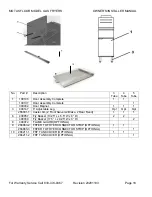
MOTAK FLOOR MODEL GAS FRYERS
OWNER’S/INSTALLER MANUAL
For Warranty Service Call 833-474-0367
Revision 20201103
Page 15
MONTHLY CLEANING
1. Perform the Weekly Cleaning procedure (see previous section).
2. Clean around burner and orifices if lint has accumulated.
3. Visually check that burner carry-over ports are unobstructed.
CLEANING STAINLESS STEEL SURFACES
To remove normal dirt, grease and product residue from stainless steel use ordinary soap and water (with
or without detergent) applied with a sponge or cloth. Dry thoroughly with a clean cloth. Never use vinegar
or any corrosive cleaner.
To remove grease and food splatter or condensed vapors that have baked on the equipment apply
cleanser to a damp cloth or sponge and rub cleanser on the metal in the direction of the polishing lines on
the metal. Rubbing cleanser, as gently as possible, in the direction of the polished lines will not mar the
finish of the stainless steel. NEVER RUB WITH A CIRCULAR MOTION. Soil and burnt deposits that do not
respond to the above procedure can usually be removed by rubbing the surface with SCOTCH-BRITE
scouring pads or STAINLESS scouring pads. DO NOT USE ORDINARY STEEL WOOL, as any particles
left on the surface will rust and further spoil the appearance of the finish. NEVER USE A WIRE BRUSH,
STEEL SCOURING PADS (EXCEPT STAINLESS), SCRAPER, FILE OR OTHER STEEL TOOLS.
Surfaces that are marred collect dirt more rapidly and become more difficult to clean. Marring also
increases the possibility of corrosive attack. Refinishing may then be required.
Darkened areas, called “heat tint,” sometimes appear on stainless steel surfaces where the area has been
subjected to excessive heat. These darkened areas are caused by thickening of the protective surface of
the stainless steel and are not harmful. Heat tint can normally be removed by the above cleaning
techniques, but tint which does not respond to that procedure calls for a vigorous scouring in the direction
of the polish lines, using SCOTCH-BRITE scouring pads or a STAINLESS scouring pad in
combination with a powered .cleanser. Heat tint action may be lessened by not applying or by reducing,
heat to equipment during slack periods.






































